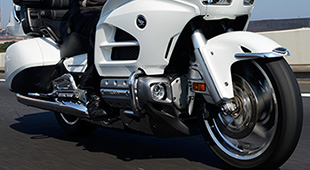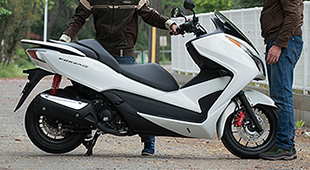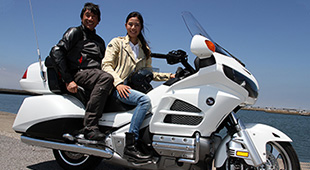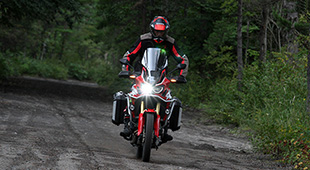Tech Views — Vol. 9 G Switch and Selectable Torque Control
Impressions (2/3)
How Helpful Is Selectable Torque Control?
How effective is the Africa Twin’s Selectable Torque Control? I made a comparison by conducting a series of start and acceleration tests while riding off-road on a gravel road surface where its effectiveness could most easily be felt. According to the engineer in charge of testing, in the development of the Africa Twin, “If the Selectable Torque Control is set to the default position (Level 3), the machine doesn’t swing very much to the left or right during acceleration, and straight line speed increases. At Level 2, where the degree of intervention is lessened by one step, the bike increases its speed by digging into the road surface a little more, but still maintains good stability. And at Level 1, where the degree of intervention is weakest, experienced off-road riders can slide the tail a little during turns with some deft throttle work, but this level still prevents any overreaction to rider inputs.”
He also said that the torque control was programmed for electronic control on the assumption that it would mostly be used on basic gravel forest trails. From that perspective, it can also be assumed that the default was intended for beginners, Level 2 for mid-level off-road riders and the least effective condition (Level 1) for more advanced riders. Naturally, however, the level of effect also differs depending on road surface conditions. Also there is a chemistry depending on rider preferences. My next test brought all these factors together.
This test was conducted by starting and accelerating from a dead stop. The main purpose was to check to see how the Selectable Torque Control intervenes in the control of acceleration immediately after a start. As with the G Switch’s dirt figure eight tests, I used two different styles of acceleration at the start to better feel the difference: one was to accelerate slowly by gradually opening the throttle to about 10 percent of full acceleration, and the other was executing a sudden leap of acceleration by quickly cranking open the throttle to about 50 percent.
I tested the difference in degree of Selectable Torque Control intervention by first setting it to the default level (Level 3), then to the weakest level (Level 1) and thirdly to OFF. This test was conducted with the running mode set to D (Drive) and the G Switch to its default position (OFF — the mode usually used when starting on paved roads), as shown in the following video.
Gravel Road Acceleration — Test 1
Selectable Torque Control: Default (Level 3)
G Switch: Default (OFF)
Throttle under acceleration: Gradual to 10%
My first test was run at the default level. Almost the instant I rolled on the throttle to about 10 percent and began to accelerate, the Selectable Torque Control intervened and the sound accompanying this acceleration changed to an intermittent engine sound. It felt like the power was being slightly interrupted, although there was a strong feeling of forward acceleration. It gave me the impression that the bike was stable and the rear wheel was pushing the bike smoothly and straightly. I sensed no unsteadiness and instead felt a strong feeling of confident security. In fact, it was such smooth acceleration that I almost forgot about the slippery road surface.
Gravel Road Acceleration — Test 2
Selectable Torque Control: Weakest degree of intervention (Level 1)
G Switch: Default (OFF)
Throttle under acceleration: Gradual to 10%
For the next test, I set the Selectable Torque Control to Level 1, its weakest degree of intervention. On the Africa Twin, this level can be easily changed using a switch on the left handlebar. Gradually rolling on the throttle to 10 percent from a standing stop, I started to move and increase speed. This time, it seemed that the degree of intervention that was causing the interruption of acceleration I experienced earlier was greatly reduced, and that speed picked up a little quicker than in the previous test. The degree of intervention became more prominent as I shifted up to 2nd. Compared to the default level, the number of times that the torque control itself repeatedly intervened also seemed to have decreased in this weaker setting.
Even at its weakest level of intervention, I felt like the Selectable Torque Control was accurately suppressing wheel slip from the start. And though riding on normal tires, I never had any feeling of conditions ever becoming dangerous. The only things the rider need do are open the throttle and concentrate on standing the bike upright so that it can increase its speed in a straight line. My feeling was that there was nothing unsettling at all about its handling, even with the day’s conditions, just as long as it was ridden straight.
Gravel Road Acceleration — Test 3
Selectable Torque Control: OFF
G Switch: Default (OFF)
Throttle under acceleration: Gradual to 10%
Next, I made an attempt with the Selectable Torque Control turned completely OFF. I figured that the acceleration would not be much different from what I’d experienced with Level 1 if the throttle were slowly opened to only about 10 percent, and sure enough the acceleration on flat ground was exactly what I imagined. I executed my starts without a hint of anxiety. No slips, either. However, if the road surface had been wet ground instead of gravel, I think the rear wheel might have easily spun. At the same time, it’s true that I was feeling a bit uneasy, and it seemed that the Selectable Torque Control’s reliable wheel slip control could be a great support to less experienced riders in terms of relieving stress.
Gravel Road Acceleration — Test 4
Selectable Torque Control: Default (Level 3)
G Switch: Default (OFF)
Throttle under acceleration: Rapid to 50%
In this next test, I compared operation with the throttle being quickly yanked open to about 50 percent. This could be referred to as rapid acceleration, and it usually never needs to be performed anywhere other than a test course. I used this technique with the idea of showing more clearly how the Selectable Torque Control works.
With the Selectable Torque Control in its default position, the degree of intervention increased the instant the throttle was opened. Gradually opening the throttle to 10 percent, as in Test 1, its control seemed to fully intervene almost the instant the throttle opened to prevent the rear wheel from slipping. I could feel it rapidly repeating the cycle of acceleration – control intervention – acceleration as I held the throttle open. Since I was holding the throttle open to 50 percent this time, if, after control intervention, I sensed some tire slip during acceleration, the torque control would intervene again briefly to attenuate the acceleration. This cycle was continuously repeated. Even so, the rear wheel didn’t slip to such a degree that I felt it was dangerous, in spite of using normal tires filled to normal air pressure.
Gravel Road Acceleration — Test 5
Selectable Torque Control: Weakest intervention degree (Level 1)
G Switch: Default (OFF)
Throttle under acceleration: Rapid to 50%
Next, I started with the Selectable Torque Control switched to its weakest setting (Level 1). Since the intervention was mild, when I first opened the throttle I could feel the rear wheel slipping more as it dug into the road surface. However, the Selectable Torque Control was also detecting this slippage and intervened to prevent it. In this case, the difference between acceleration and deceleration at start and intervention was larger than the intervention experienced in the default mode (Level 3). The bike chattered noticeably as speed increased. Perhaps this could be best described as, “As speed increases, the difference in interruption of acceleration as traction control is enabled was larger because the feeling of the rear wheel gripping the road surface was stronger.” However, in spite of this, I felt that the acceleration was quicker. These were the sort of results one would normally get on a gravel road surface.
Gravel Road Acceleration — Test 6
Selectable Torque Control: OFF
G Switch: Default (OFF)
Throttle under acceleration: Rapid to 50%
Turning OFF the Selectable Torque Control, I quickly whipped the throttle open to 50% from a standing stop. I felt like acceleration had so far proceeded without a hitch despite the torque control intervention. But was it only my own experience that was suppressing the rear wheel slip? This sort of made me nervous.
This time, the rear wheel started spinning the instant I opened the throttle, and I could hear the sound of gravel being thrown backward. As a result of a slight loss of balance, the bike began a tail slide. My impression was that, rather than sliding in the direction of acceleration, the applied drive force was escaping horizontally with resultant violent behavior.
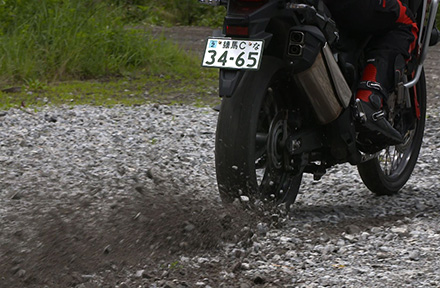
I thought this was better than if normal tires were used or it was a level based on the assumption that off-road tires were mounted. Or a level of control one would select for riding on sandy beaches. I broke out a bit in a cold sweat.
The impression I had so far was that I might have been overly optimistic in thinking I could manage to control my riding without the assistance of this electronic Selectable Torque Control. However, as I opened the throttle wider, or as changes in road surface conditions became more pronounced, the amount of work I had to do riding with the torque control disabled increased dramatically. Obviously, this would also depend on rider skill. However, it was all I could do to keep the throttle cranked opened to 50 percent. My honest feeling was that the bike was skidding out of control.
This time, since the purpose of the test was to make comparisons based on identical conditions, I tried to keep the amount of throttle constant. But the fact that the Selectable Torque Control was intervening meant that the rear wheel would otherwise spin on slippery road surfaces. In other words, it follows that acceleration could be made easier by rolling back the throttle to reduce rear tire slip. In the future, it’ll be a real pleasure to pursue more advanced riding techniques while making the best use of this new control.
Above all, my anxiety about sliding was putting a heavy strain on my body. As speed rapidly increased, the rear wheel would slip whenever my center of gravity shifted the slightest degree off the bike’s center. Even travelling straight forward seemed to require more advanced skill than expected. I began to understand what a powerful effect the Selectable Torque Control was having on handling.
I conducted one more series of tests. This time starting out on an uphill grade. In this test, I used only two of the Selectable Torque Control modes, default (Level 3) and OFF, and compared the response with the throttle gradually opened to 10 percent and again when rapidly opened to 50 percent. Planting my left foot on the ground and stopping with my right foot on the rear brake, I open the throttle to take off — the usual procedure for slope starts.

